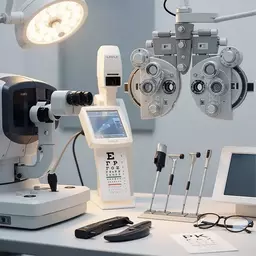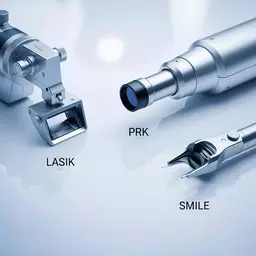Laser Eye Surgery: Cost vs. Benefit

Have you ever considered the real cost of improving your vision? Understanding the financial implications of laser eye surgery can empower you to make an informed choice about your eye care.
What You Will Learn
- Laser eye surgery, particularly LASIK, reshapes the cornea to improve vision, often providing quick recovery and lasting results.
- While LASIK may involve a higher initial cost, it can lead to long-term savings compared to the ongoing expenses of glasses and contacts.
- Hidden costs post-surgery, such as follow-ups and potential complications, are essential to consider when evaluating LASIK’s overall affordability.
- Understanding eligibility criteria, including eye health and stable prescriptions, is crucial before deciding on LASIK.
Comparing LASIK to Traditional Vision Correction & Costs
This visual outlines the key differences between LASIK and traditional vision correction (glasses/contacts), focusing on initial vs. long-term financial implications and patient eligibility criteria. For a more detailed breakdown of these differences, consider exploring various LASIK vs. PRK vs. SMILE costs and their value propositions.
LASIK: Initial vs. Long-Term Costs
While initial investment can be higher, LASIK offers significant long-term savings by eliminating recurring expenses.
- ✓ Avg. cost: AUD 2,000-3,500 per eye.
- ✓ Potential cost-effective over time.
- ✓ Freedom from corrective eyewear.
Traditional Methods: Ongoing Costs
Glasses and contact lenses require continuous purchases and appointments, leading to accumulating expenses.
- ● Yearly expenses > AUD 500.
- ● Requires ongoing replacements.
- ● Recurring costs for exams/prescriptions.
LASIK Eligibility & Key Factors
Assessing candidacy is crucial for a successful LASIK journey, considering vision, health, and lifestyle.
- ■ Age: Typically 18+.
- ■ Stable prescription for 1+ year.
- ■ Good overall eye health.
- ■ Realistic expectations.
Understanding Laser Eye Surgery and Its Financial Implications
At VisionCost Insights, we’re here to help you navigate the world of laser eye surgery and its financial implications. With my experience as an ophthalmologist, I’ve seen firsthand how this transformative procedure can impact lives. Understanding the fundamentals of laser eye surgery is crucial, especially when considering the costs associated with it. Let’s dive into what laser eye surgery is and how it works!
What is Laser Eye Surgery and How Does It Work?
Laser eye surgery is a popular option for those seeking to improve their vision. It uses advanced technology to reshape the cornea, allowing light to focus correctly on the retina. The most common procedures include LASIK, PRK, and SMILE, each employing different methods to achieve clear vision. Let's look closer at LASIK, which is the most recognized.
Overview of LASIK and Common Procedures
LASIK, or Laser-Assisted In Situ Keratomileusis, involves using a laser to create a flap in the cornea, followed by reshaping the underlying tissue. This procedure is renowned for its quick recovery time and minimal discomfort. Here are some key points about LASIK:
- Quick procedure, often completed in under 30 minutes
- Minimal pain with fast recovery, usually within 24 hours
- Long-lasting results, often eliminating or significantly reducing the need for glasses or contacts
Understanding these benefits can help you weigh your options if you're considering vision correction.
How LASIK Compares to Traditional Vision Correction
When comparing LASIK to traditional methods like glasses and contact lenses, there are notable differences. LASIK can offer a permanent solution, while glasses and contacts require ongoing costs and replacements. Think about the long-term financial impact:
- Initial investment in LASIK may seem high, but it can lead to savings over time.
- Glasses and contacts incur recurring costs for prescriptions and replacements.
- LASIK can enhance your lifestyle by providing freedom from corrective eyewear.
Ultimately, the choice between LASIK and traditional methods boils down to personal preference and financial readiness. To better understand the different approaches, you can review various laser eye surgery types explained to see which aligns best with your needs.
Breaking Down the Costs of LASIK
Understanding the costs involved in LASIK is essential for making an informed decision. The expenses can vary widely based on factors such as technology used and the surgeon's experience. Let’s break down the costs so you can see the full picture!
Initial Costs vs. Long-Term Expenses of Glasses and Contacts
When considering the financial aspect, it’s vital to compare the initial costs of LASIK against the long-term expenses of maintaining glasses and contacts. An analysis often reveals that:
- The average LASIK cost in Australia can range from AUD 2,000 to AUD 3,500 per eye.
- Yearly expenses for glasses and contacts can exceed AUD 500, including exams, prescriptions, and replacement parts.
- Over time, LASIK can become a cost-effective choice, offering potential savings.
By evaluating these costs, you can make a more informed decision about whether LASIK is the right choice for you.
Hidden Costs to Consider: Follow-Ups and Potential Complications
It’s important to be aware of hidden costs that can arise after the initial procedure. Follow-up visits are generally included in the initial fee, but potential complications could lead to additional expenses. Consider these factors:
- Follow-up consultations usually occur within the first year.
- Possible enhancements or touch-up procedures might incur extra costs.
- Understanding your clinic’s policy on post-operative care can help prepare for unexpected expenses.
Being proactive about these factors can prevent surprises later on.
Cost Analysis: What Makes LASIK Worth the Expense?
Evaluating the worth of LASIK involves considering both tangible and intangible benefits. The investment can pay off in numerous ways:
- Improved quality of life and convenience—imagine waking up and seeing clearly without glasses!
- Increased confidence in daily activities, from sports to social events.
- Potential savings in long-term vision care costs.
By assessing these benefits, you can better appreciate the value of investing in your vision.
Evaluating Savings and Return on Investment (ROI)
When it comes to LASIK, evaluating your potential savings and return on investment is key. Understanding how the procedure can benefit you financially and personally helps clarify the decision-making process.
Pro Tip
Did you know? Many laser eye surgery clinics offer financing options that can help make the initial cost more manageable. It’s worth inquiring about payment plans or third-party financing to ease your financial burden while ensuring you receive the vision correction you desire!
Making an Informed Decision About Laser Eye Surgery
Deciding whether to undergo laser eye surgery, like LASIK, is a significant choice! As someone who has been in the field for over a decade, I understand how overwhelming the process can be. My goal here at VisionCost Insights is to provide you with the clarity you need to make an informed decision that feels right for you.
Assessing Your Readiness for LASIK
Are you ready to take the plunge into the world of laser eye surgery? It’s crucial to assess your candidacy for LASIK before you move forward. This means evaluating your vision, overall health, and lifestyle. Here are some factors to consider:
- Age: Being over 18 is typically required.
- Stable Prescription: Your vision prescription should be stable for at least a year.
- Eye Health: Conditions like dry eyes or corneal thickness can affect eligibility.
- Expectations: Understanding what LASIK can and cannot do for you.
Gathering this information helps pave the way for a successful experience. If you match these criteria, it’s worth consulting an expert to discuss your vision correction options! For a deeper dive into the specific elements that influence the final price, refer to our guide on factors affecting laser eye surgery cost.
Consultation: What to Expect During Your Eye Exam
Your initial consultation is a vital step in the LASIK journey! During the exam, our team will conduct a series of tests to evaluate your eye health and vision quality. You can expect:
- Comprehensive eye exams, including vision tests and corneal mapping.
- Discussion of your medical history and current medications.
- Assessment of your candidacy based on test results.
- Clear communication about the procedure, expected outcomes, and risks.
This thorough evaluation is designed to ensure you are well-informed and comfortable moving forward. Remember, asking questions is encouraged!
Eligibility Criteria: Key Factors to Consider
When considering LASIK, it’s essential to know the eligibility criteria. Besides age and prescription stability, here are some key factors:
- Overall Health: Chronic conditions like diabetes may affect healing.
- Realistic Expectations: LASIK can significantly improve vision, but it may not eliminate the need for glasses altogether.
- Commitment to Follow-Up Care: Post-operative appointments are crucial for monitoring recovery.
By understanding these factors, you can better gauge your readiness for laser eye surgery!
Life After LASIK: Long-Term Considerations
After undergoing LASIK, you’ll likely experience substantial changes in your vision. But what does life look like post-surgery? Here’s a breakdown of what to expect:
- Improved Vision: Most patients achieve 20/25 vision or better!
- Reduced Dependency on Glasses or Contacts: Enjoy newfound freedom!
- Potential for Dry Eyes: This can occur temporarily as your eyes heal.
- Follow-Up Care: Regular check-ups to ensure optimal results.
Understanding these changes can help you adapt more comfortably to your new vision!
Adapting to New Vision: What Changes Can You Expect?
Adjusting to life after LASIK can be an exciting yet challenging experience. Initially, you may notice:
- Slight Blurriness: This is common but should improve within a few days.
- Increased Sensitivity to Light: Your eyes may take some time to adjust.
- Visual Fluctuations: Your vision might change over the first few weeks.
Give yourself time to adapt. Embrace the changes as you enjoy clearer sight!
Managing Aging Vision: How LASIK Interacts with Presbyopia
As we age, many people encounter presbyopia, which affects near vision. LASIK can help correct vision issues, but it's important to know:
- LASIK may not prevent presbyopia: You could still need reading glasses later.
- Discuss options for managing presbyopia with your surgeon.
- Regular eye exams remain essential to monitor changes.
Staying informed about how LASIK interacts with aging vision can help you plan for the future!
Post-operative Care and Recovery Time: What to Anticipate
After LASIK, following post-operative instructions is crucial for optimal recovery. Here’s what you can expect:
- Rest for 24 hours: Take it easy after the procedure!
- Use prescribed eye drops: This helps prevent dryness and infection.
- Avoid eye makeup and swimming for a week: Give your eyes time to heal.
- Follow up with your surgeon: Regular check-ups are key!
Being proactive about your recovery can lead to the best possible results. Remember, your journey to clear vision is worth it!
Final Thoughts on the Cost-Benefit of LASIK
As you consider if laser eye surgery is worth the investment, reflect on the long-term benefits. It’s not just about the initial costs but also about the life-changing impacts on your daily activities!
Is Laser Eye Surgery Worth the Investment for You?
Ultimately, the decision to undergo LASIK should align with your personal goals and financial situation. Think about your lifestyle and how much you rely on glasses or contacts. For many, the freedom that LASIK provides makes it a worthwhile investment!
Encouragement to Consult a Specialist and Explore Options
I encourage you to reach out to a qualified specialist for personalized advice. A comprehensive consultation can shed light on your options and help you navigate potential risks.
Patient Education Resources for Making an Informed Choice
At VisionCost Insights, we are dedicated to providing you with reliable information to support your decisions. Explore our resources for more insights into laser eye surgery and its financial implications!
Frequently Asked Questions About LASIK Costs
What is the average cost of LASIK eye surgery in Australia?
The average cost for LASIK in Australia typically ranges from AUD 2,000 to AUD 3,500 per eye, depending on various factors like the clinic, technology used, and the surgeon's experience.
Are there any hidden costs associated with LASIK?
While most initial fees cover the procedure and immediate follow-ups, potential hidden costs can include touch-up procedures or additional treatments for complications. Always clarify your clinic's policy on post-operative care.
How does the cost of LASIK compare to the long-term expense of glasses and contacts?
Although LASIK has a higher upfront cost, it can be more cost-effective in the long run. Yearly expenses for glasses, contact lenses, and eye exams can exceed AUD 500, accumulating significant costs over many years, while LASIK is a one-time investment.
What factors determine eligibility for LASIK surgery?
Key eligibility criteria include being over 18 years old, having a stable vision prescription for at least one year, good overall eye health, and realistic expectations about the outcomes. Conditions like severe dry eyes or thin corneas can affect candidacy.
Will LASIK prevent me from needing reading glasses as I age?
LASIK corrects existing refractive errors but does not prevent age-related presbyopia, which affects near vision. You might still require reading glasses later in life. Discuss options for managing presbyopia with your surgeon.
Recap of Key Points
Here is a quick recap of the important points discussed in the article:
- Laser eye surgery, including LASIK, is a popular and effective way to improve vision.
- While the initial cost of LASIK can be high, it may lead to long-term savings compared to glasses and contacts.
- Be aware of hidden costs such as follow-up visits and potential complications that might arise after surgery.
- Assess your eligibility for LASIK by considering factors like age, prescription stability, and overall eye health.
- Post-operative care and follow-up appointments are crucial for optimal recovery and results.








